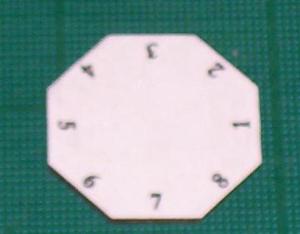It was way back in February that I promised a step-by-step of how I plan to do casualty markers and I’ve finally got round to doing it. Part of the delay has been the usual stuff about life getting in the way but the other part is that I’ve been experimenting with the various ways I might get the numbering on to the bases. I’ve been through a range of candidate solutions including home-made transfers, Letraset and indiviually printed and glued numbers. None of these, for various reasons, have proved satisfactory.
A recent re-organization of the family computers and home wireless network proved to be the trigger for the solution I’ve now settled on. The computer in the study now runs Windows Vista and we have the latest version of Microsoft PowerPoint installed on it. This new version of PowerPoint includes octagons and hexagons in its arsenal of standard shapes, which has made it much easier to design correctly shaped and sized overlays for my casualty bases. You might recall that I have batches of 1.5mm thick 40mm wide laser-cut plywood bases from Litko.
So let’s get stuck into the first few steps then:
STEP 1: Design the overlays
As mentioned, I used Microsoft PowerPoint to design my overlays for octagonal bases (I’ll do hexagonal ones the same way at some point in the future). I’ve managed to create an A4 sheet of 12 overlays (no point in wasting paper) and each overlay has the numbers one through eight around the edges. And because I’m a nice kind sharing person, I’ve uploaded a copy of this overlay sheet for people to use freely if they wish. I don’t mind any personal non-commercial use of these overlays but please note that I have asserted copyright and I won’t be happy if people infringe my rights for commercial gain.
Download 40mm octagonal casualty base overlays. This version of the file is (I hope) backwards compatible with older versions of PowerPoint.
 STEP 2: Print and cut out overlay
STEP 2: Print and cut out overlay
I’ve printed off a sheet of overlays using my HP DeskJet printer. I reckon any ink jet or laser printer will do the job. Bear in mind that the overlay sheet is designed for A4 sized paper, so if you’ll have to make adjustments if you’re used to US legal sized paper.
Once printed, you can cut out the overlay. I recommend the use of a steel rule and a scalpel to get clean neat straight edges but please take appropriate safety precautions when using sharp tools.
STEP 3: Prepare the base
A quick and simple step but one that’s well worth the effort. Just inspect your chosen base and clean up any rough edges. If, like me, you’re using Litko (or any other brand of) laser-cut bases, you should wipe round the edges with a clean damp cloth to remove any black soot residue left over from the cutting process. You don’t want this black residue to contaminate the overlay and make it dirty.
 STEP 4: Glue the overlay to the base
STEP 4: Glue the overlay to the base
I use watered down PVA glue for this step. Simply paint a thin film of the diluted glue on the base and slide the overlay into position. Try to keep you hands clean and clear of glue and use a dry towel to pat the overlay firmly down on the base and smooth out any air bubbles (not that I had any problems with these). The idea here is to avoid handling the surface of the overlay as much as possible to minimze the risk of it getting dirty. Now set aside to dry for a couple of hours.
Er… Sorry the photo of the glued overlay is out of focus. I’ll try to replace it with a better picture later.
Once the glue is dry we’ll move on to varnishing and basing up the casualty figure. More detail about these steps later in part two.

 RSS 2.0 feed
RSS 2.0 feed


 “For my games I use a collection of ‘dead and wounded’ figures mounted on 25mm square card as Casualty Markers. Half of the markers are numbered 1234 around the four sides, the other half 4567 around the sides. The marker is then placed next to a unit once it takes casualties, with the appropriate casualty marker number actually in physical contact with the unit. As casualties mount the marker is turned round to show the current casualty state. Once the casualties reach the number of figures on a base, a base is removed.”
“For my games I use a collection of ‘dead and wounded’ figures mounted on 25mm square card as Casualty Markers. Half of the markers are numbered 1234 around the four sides, the other half 4567 around the sides. The marker is then placed next to a unit once it takes casualties, with the appropriate casualty marker number actually in physical contact with the unit. As casualties mount the marker is turned round to show the current casualty state. Once the casualties reach the number of figures on a base, a base is removed.”
